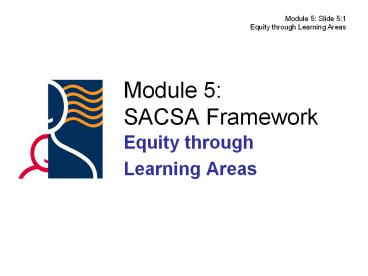Module 5: SACSA Framework - PowerPoint PPT Presentation
1 / 11
Title:
Module 5: SACSA Framework
Description:
This Module focuses on an exploration of Learning Areas to identify ways in ... way the Learning Areas have been transformed and redefined by the interweaving ... – PowerPoint PPT presentation
Number of Views:17
Avg rating:3.0/5.0
Title: Module 5: SACSA Framework
1
Module 5SACSA Framework
Module 5 Slide 51 Equity through Learning Areas
- Equity through
- Learning Areas
2
Introduction
Module 5 Slide 52 Equity through Learning Areas
- This Module focuses on an exploration of Learning
Areas to identify ways in which the SACSA
Framework supports genuinely inclusive
curriculum, teaching and curriculum content about
Equity.
3
Purpose of the Module
Module 5 Slide 53 Equity through Learning Areas
- To develop an understanding of the way the
Learning Areas have been transformed and
redefined by the interweaving of the Essential
Learnings, Equity Cross-curriculum Perspectives
and Enterprise and Vocational Education.
4
A Focus on Equity
Module 5 Slide 54 Equity through Learning Areas
- The SACSA Framework reaffirms a long held belief
that education is central to the making of a
fairer society.
5
A Curriculum Perspective
Module 5 Slide 55 Equity through Learning Areas
- When curriculum favours those who already have
the largest share of financial and cultural
resources it contributes to the maintenance of
the unequal distribution of wealth and power in
society. - (General Introduction, SACSA Framework, p 18)
6
Module 5 Slide 56 Equity through Learning Areas
- In the SACSA Framework the Learning Areas have
been transformed and redefined by interweaving
the Essential Learnings, Equity Cross-curriculum
Perspectives and Enterprise and Vocational
Education through every level of the framework. - (General Introduction, SACSA Framework, p 25)
7
Module 5 Slide 57 Equity through Learning Areas
- Key Ideas comprise the fundamental concepts of
the Learning Areas. The following examples
demonstrate how educators can focus learners
attention on both - Learning Areas content
- The Three Es
- -Essential Learnings
- -Enterprise and Vocational Education
- -Equity Cross-curriculum Perspectives
8
Module 5 Slide 59 Equity through Learning Areas
- Discuss the annotations in the examples of the
Key Ideas, and identify other opportunities for
teaching Equity Cross -curriculum Perspectives
and Enterprise and Vocational Education. - Identify the key words and phrases (Eg social and
cultural), that provide opportunities to examine
different equity perspectives.
9
Module 5 Slide 510 Equity through Learning Areas
- Annotate the Outcomes and examples of evidence of
either English or Maths using the annotation of
the Key Ideas (Resources 5.2 5.3) as a model. - Look for key words and phrases such as
- purpose (eg Whose purpose and in whose interest
is the text constructed?) - critical understanding (eg Whose voices are
heard? Who is included and excluded?)
10
Equity through the Learning Areas
Module 5 Slide 511 Equity through Learning Areas
- To enable all learners to achieve the
Developmental Learning Outcomes and curriculum
standards, educators need to construct curriculum
that is inclusive, recognises and builds upon
learner diversity and provides every learner with
learning and assessment experiences which
optimise their opportunities.
11
Something more Teachers work
Module 5 Slide 512 Equity through Learning Areas
- In good teaching, the improvisation goes beyond
boundaries an enthusiasm or concern, a capacity
to judge the right moment, which sparks a
learning process, inspires a pupil, or
communicates a love for knowledge and respect for
the learner - The interests is a learners and behind the
learner, the societys collective interest in the
new generation learning well. Good teaching,
thus, involves a gift relation. It is a practice
founded on public rather than a private interest. - (R.W. Connell 1996)































